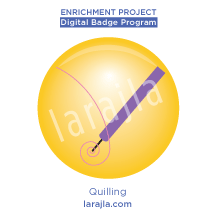 Quilling is a paper craft that’s been around for hundreds of years. The tools you need are minimal and the final effect is very cool. You can use quilled items for cards, jewelry, ornaments and more. Let’s start rolling!
Quilling is a paper craft that’s been around for hundreds of years. The tools you need are minimal and the final effect is very cool. You can use quilled items for cards, jewelry, ornaments and more. Let’s start rolling!
.
Steps
1. Introduction.
Quilling, also known as paper filigree, is a paper craft that involves strips of paper that you roll, shape and glue to create art. It might be as simple as a flower bud or a complicated three-dimensional ornament. This craft can be very easy as you can purchase pre-cut paper strips or it can be very economical by making your own supplies and tools.
2. History.
Many countries claim to be the originator of quilling. Unlike many old crafts, quilling did not vanish over time. Instead, resurgence has kept this craft alive. Read about the history of quilling and its growing popularity today.
3. Explore the Web.
From lessons to patterns to very intricate art, you can find a lot of examples of quilling. Explore the Web and find one or more items that you would like to try yourself.
4. Tools.
You can do quilling with only three items.
- Paper
- Glue
- Needle
Of course, there are many other tools out there that make it easier to quill as well as do more complicated filigree. Look at the tools you might use. Decide if you want to invest in this craft or start with your three main items only and see if you enjoy quilling before making a larger investment.
5. Simple shapes — rolls.
With the Simple Shapes Worksheet, make one sample of each of the thirteen rolls. Glue your samples onto the sheet for reference. If you need more help with the shapes, go to YouTube for video instructions.
6. Simple shapes — scrolls.
With the Simple Shapes Worksheet, make one sample of each of the five scrolls. Glue your samples onto the sheet for reference. If you need more help with the shapes, go to YouTube for video instructions.
7. Simple shapes — spirals.
A spiral may also be called a tendril. Unlike most shapes that tend to hold the same spiral, these are long, twisting pieces of paper. You might think of spiral curls as an example. Create a spiral / tendril and attach it to your Simple Shapes Worksheet.
Slide your completed worksheet into a sheet protector so you continue to use this reference sheet.
8. Making items with simple shapes.
Use your basic quilling knowledge and make simple items such as a flower or balloon. Single shapes can be placed on cards, scrapbook pages or even made into pendants and earrings. For jewelry pieces, make sure to seal the paper first to stiffen it and keep it clean.
9. Advanced shapes — rolls.
With the Advanced Shapes Worksheet, make one sample of each of the two rolls. Glue your samples onto the sheet for reference. If you need more help with what the shapes, go to YouTube for video instructions.
10. Advanced shapes — scrolls.
With the Advanced Shapes Worksheet, make one sample of each of the five scrolls. Glue your samples onto the sheet for reference. If you need more help with the shapes, go to YouTube for video instructions.
11. Advanced shapes — eccentric.
With the Advanced Shapes Worksheet, make one sample of each of the seven eccentrics. Unlike the shapes you’ve created so far, eccentrics follow the same shape guidelines but you control where the center of the roll is placed. This gives your final quilled piece a more “artistic” and less “haphazard” look. Glue your samples onto the sheet for reference. If you need more help with the shapes, go to YouTube for video instructions.
12. Technique — husking.
Husking is the next step after eccentrics. Where you control the center of an eccentric, husking is wrapping the paper around points to create a shape. Husking is popular for leaves to give them a more structured look. Try creating a husking shape. Place it on your sheet or write notes about any tips / tricks you want to remember.
13. Technique — fringing.
Fringing is cutting down into the side of the strip to make a fringe. Fringing can be done by hand, but it is very tedious. Fringe a strip of paper, then roll it and loosen up your fringe. Place this on your Advanced Shapes Worksheet as well.
NOTE: The cost of a fringer may not be worth it for you if you don’t plan to use it frequently. The time savings is enormous if you choose to get one.
14. Making more advanced items.
Follow the simple pattern ideas, but use the advanced shapes you created. Compare the looks and decide which you like more.
15. Changing it up!
Traditionally, paper is used for quilling. However, you can find quilled items where corrugated cardboard and felt is used instead of paper. Try creating one or more of the shapes above with a material other than paper.
16. Share your knowledge.
Show someone else how to quill. If you’re working with a large group, a tinker toy works great to roll paper on as everyone can see it. Cut strips from an 11 x 17 sheet for demonstration purposes.
17. Share your work.
Share what you’ve created with others. You can send cards you’ve made or even photos of quilled items you’ve completed.
Supplements Available
SUPP_Quill_AdvancedShapeWorksheet.pdf
SUPP_Quill_SimpleShapeWorksheet.pdf
.
Sites to Explore
- en.wikipedia.org/wiki/Quilling
- www.myquilling.com
- craftzine.com/101/quilling
- weirdandsurprisinglygood.blogspot.com/2009/09/art-lesson-2-quilling.html
- www.whimsiquills.com/servlet/the-template/Quilling%20Refernce%20Materials/Page
- quillingwithwhimsiquills.blogspot.com/2007/07/teachinglearning-quilling-part-1.html
- www.origami-resource-center.com/quilling.html
- www.naqg.org
- www.quilling-guild.co.uk/index.htm
- ladyrain.hubpages.com/hub/Paper-Quilling-Making-Huskings
- quilling.blogspot.com/2006/12/how-to-make-fringed-flowers.html
- www.craftcreations.com/Section/939/Free-Craft-Projects (look through products for quilling)
Leave a Reply